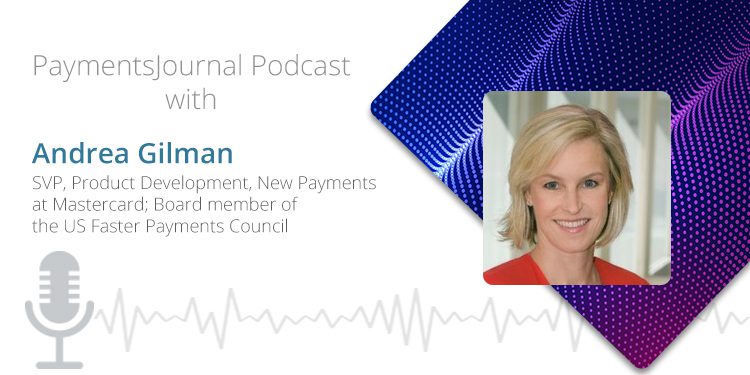Consumers, Businesses and financial institutions alike are turning towards faster payment options in large numbers, embracing the improved speed, data sharing, and messaging capabilities afforded by these new payment methods.
As is the case with any emerging technology, companies are still trying to determine the best use cases to harness faster payments’ potential. One company at the forefront of this is Mastercard.
To learn how Mastercard is leveraging faster payment capabilities, PaymentsJournal sat down with Andrea Gilman, SVP of Product Development at Mastercard, and Sarah Grotta, director of Debit and Alternative Products Advisory Service at Mercator Advisory Group.
During the discussion, Gilman and Grotta discussed the state of real-time payments, promising applications of this payment capability, and how Mastercard is approaching innovations.
The key trends and drivers of real-time payments
Due to the proliferation of technology, modern life has become increasingly mobile, instant, and connected, said Gilman. This in turn is shaping consumer preferences and expectations, causing people to want a frictionless user experience. Real-time payments has the potential to deliver just that.
We are in an age accelerated by real-time expectations, which is driving worldwide reform. Against this backdrop, real-time payments have been gaining traction around the globe—countries representing 87% of the world’s GDP are already launching real-time payments systems.
Real-time payments have also been gaining momentum in the U.S. since launching in 2017. Many banks are connected or are in the process of connecting to the RTP network, TCH’s real-time payments rails. Grotta mentioned that the FedNow announcement has solidified real-time payments permanence in the market. As such, many smaller financial institutions are starting to implement strategies to offer real-time payment solutions in order to keep their customers happy.
With more banks becoming connected to faster payment rails, they are now considering applications of the technology. And now that there is an interest in exploring real-time payment solutions, Gilman noted that there’s a lot of great opportunities for real-time payments to bring value to the marketplace.
Grotta noted that financial institutions are also shifting focus and are developing real-time payments applications beyond the typical person-to-person use cases where they initially focused. They are finding use cases where real-time or faster disbursement transaction are really desirable. As a result, there’s been an increase in B2B and B2C applications, from use cases involving payroll to insurance payouts.
The real opportunities for real-time payments: Information with the payment
While real-time suggests absolute immediacy, its greater advantage may be the power of the enhanced data that can travel together with the transaction. This can lead to greater security, scalability, efficiency, and a common global language – this is in addition to 24/7/365 accessibility. Many of the opportunities are related to passing rich information with the payment and messaging capabilities.
Passing rich information means being able to pass digital invoice information during the request for payment and also when the payment is made. This will solve a lot of pain points associated with reconciliation, a major problem in the business space. There’s a lot of opportunity around businesses that collect cash and checks. For example, delivery drivers often have to wait around to collect a payment, thereby wasting valuable time. It also creates a security concern, as drivers often find themselves physically holding significant amounts of cash.
Consumers would benefit from the improved data capabilities as well. For example, when a consumer pays a bill via a real-time payment rail, they receive a real-time alert that the bill was received, a feature that is particularly helpful if the consumer is paying the bill at last minute.
With such robust capabilities, we can expect to see a new era of innovations to emerge, impacting multiple use cases and flows including P2P, C2B, B2C and B2B.
Mastercard’s strategy in the real-time payments ecosystem: Adding value and providing choice
At a general level, Gilman mentioned Mastercard is looking to leverage real-time payments to solve the inefficiencies across several use cases. B2B payments provides the largest opportunity and where the most value can be added to the industry overall.
Another important principle guiding Mastercard’s approach is payment optionality. Mastercard wants people to be able to pay on which ever rail they choose. “We believe that people should be able to decide how they want to pay,” said Gilman.
These two principles underpin Mastercard’s three tiered approach to taking products to market. The first tier, which Gilman described as Mastercard’s core, refers to the infrastructure layer. This includes Mastercard’s Vocalink and Nets, two companies that provide payment rails in the United States and abroad.
The second tier refers to the “application or product layer that rides on top of the rails,” said Gilman. These products include applications such as Payment on Delivery and the Bill Pay solutions. Both products are designed on platforms enabling multi-rail capabilities.
The final tier—services—aims to provide consulting, data analytics, and fraud services to enhance account based capabilities to meet the rapidly changing ecosystem. Gilman provided an example of the fraud services that Vocalink shares with The Clearing House network.
Real-time payments spurs new innovations: Payment on Delivery
Mastercard has been actively innovating in the real-time payment space. Mastercard partnered with ecosystem partners such as PNC Bank to pilot Payment on Delivery, a solution that allows businesses to pay suppliers in real-time when receiving goods or services. The solution was first rolled out in the alcohol industry, but Mastercard plans on expanding into other industries.
By digitizing B2B payments, Payment on Delivery solves pain points related to reconciliation, information, and data.
So far, Gilman reported that the solution has been met well by the industry: “We’re hearing really positive feedback and we’re very encouraged.”
“We believe that these new capabilities will allow corporates, banks, ERPS, and all the players to achieve a form of competitive differentiation,” said Gilman.
And with more banks becoming hooked into the faster payment rails Mastercard anticipates a new era of innovation within the payments space.
